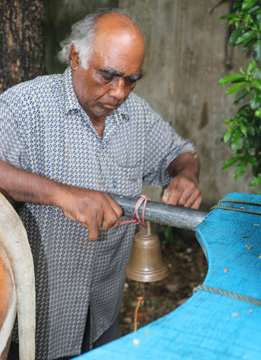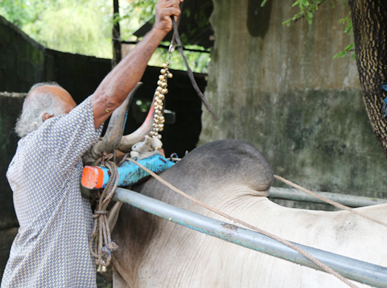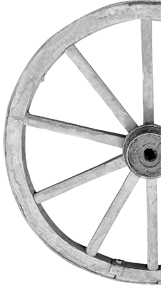Sri Lankan Bullock Cart, and The Rest of the Story........
I visited the home of my birth Sri Lanka, for the first time after a fifty five plus year absence in 2014. It was a remarkable and memorable trip in many, many ways, and allowed me to come back to my home in California with a wonderful and varied collection of images. The image below, is of a bullock cart carrying a drum of kerosene that we happened to spot in our final days in Colombo, the city of my birth and the last place I lived with my family prior to immigrating to Australia in 1958. A shot of a bullock cart, a typical and memorable sight of my childhood, was one of my goals when I arrived back in the country. A bullock cart is a two-wheeled or four-wheeled vehicle pulled by oxen (bullocks). It is a means of transportation used since ancient times in Sri Lanka, as well as many parts of the third world. They are still used today where modern vehicles are too expensive or the infrastructure does not favor them, especially for carrying goods, traditionally agrarian and lumber. The cart is attached to a bullock (or team) by a special chain attached to yokes, but a rope may also be used for one or two animals. The driver and any other passengers sit on the front of the cart, while the load is placed in the back.
During our twenty one day tour of the island we had not seen a bullock cart until this day, which made me hurriedly get out of the tour bus and try and get myself in a position to capture an image before it began moving again. I was able to include a few omnipresent tuk tuks, an automated rickshaw, which is clearly the most popular mode of transportation by the local Sinhalese and Tamil populations (arguably next to the bicycle). I was happy to have finally found and captured the image, but I do remember wondering about what it must be like to ride this rig everyday, specially being exposed to the putrid smells of the road - the diesel fumes from big buses and cargo carrying lorries and trucks, not to mention the flatulence from the bullock just ahead of you as the driver!
This blog was written after all this time, surreptitiously indeed, when my cousin Michael (who was with me when this photograph was taken) forwarded to me a link to an article that was just published in the Sunday Observer, Sri Lanka's largest circulation English newspaper. Coincidentally, this is the same newspaper that published several articles written by my father J.A.R. Grenier in the 1950s. I was stunned when I first read the article to find out that this bullock cart is the only one of its kind in Colombo, and indeed the same one that we had found and photographed a little over two years ago. Gave new meaning to 'it's a small world'!
It is a heartfelt and informative story about the owner of this bullock cart and business, Mr. A. Chandana, and the trials and tribulations of his livelihood who has been doing this for "about 55 years". I do not want to be a spoiler of the story that I have included below that I encourage you to read completely, but Mr. Chandana says "I manage to scrape up about 1,200 - 1,500 rupees a day.” That translates to about US$8-10 per day, which I spend every time I go to the movies! He goes on to say "My needs, the bullocks needs, the household needs, the children’s needs - everything is taken care of with this money.”
This story and the plight of this man and his family brings to mind vivid memories of growing up in this magical island, and the stark and austere lives of the local people who struggle to eek out a living, yet who seem to be blessed with an unusual and upbeat disposition uncommon in the West, where our daily lives seem to be 'burdened with interruptions to our local WiFi or problems with our 200 TV channels of infotainment'. I am left feeling humbled with a new found gratitude for all that I have in my daily life!
And now, please read the Rest of the Story............
http://archives.sundayobserver.lk/2016/05/22/spe-cit-01.asp
 |
The Last of the Bullock Carts
Sunday, May 22, 2016 (© 2016 Sunday Observer All Rights Reserved)
Are Colombo’s fuel-carting bovines on their last legs?
On a wet morning one Wednesday, we happened upon a wizened old man trundling past the Independence Square on a rickety, blue, bullock cart; A. Chandana claims he is the last of a species: A kerosene-vendor who uses a container pulled by a single Ox to transport his fuel around the city.
There was a time, recalls Marini, a long-time resident of Jaya Road, Bambalapitiya,that the ‘bullock-uncle’ - as we would call him, would come faithfully to the house with his ‘karaththey’ (cart) every day. “We were school children, so we didn’t know very much about what he did or why he was there, but I do remember sneaking up to the bull, with my siblings, and trying to make friends with him.”
Ashamed
Ann, a resident of Colpetty, remembers the same things: “Born and bred in the heart of Colombo, I am ashamed to say we didn’t know very much about what these men did, or why they were home,” she said. “But in a very British-brought-up-on-Enid-Blyton-fashion, we tried to feed the bullock sugar ‘cubes’ (virtually impossible to find!), and entice it with fruit!”
“I don’t remember the last time I saw one, though,” she said. “Anyway, they are from a time gone by”.
It is against this backdrop that Chandana makes his unhurried appearance. Dressed in faded shorts, a checquered shirt and with a hat pulled down firmly on his head, Chandana chews his betel slowly, taking time to think, before he speaks.
 “About 55 years now,” he says in response to the question – ‘how many years in the business?’ Chandana says he began playing his cart in 1964. “At that time, a gallon of kerosene oil was 76 cents,” he said. “Now it is about Rs. 55 a litre.”
“About 55 years now,” he says in response to the question – ‘how many years in the business?’ Chandana says he began playing his cart in 1964. “At that time, a gallon of kerosene oil was 76 cents,” he said. “Now it is about Rs. 55 a litre.”
Discount
Born in Colpetty, A. Chandana is now a resident of Maradana, Colombo 10. He begins his work early: “I get my fuel from the ‘shed’,” he said.
“No, I don’t get a discount – I get for the same amount that other people get it for.”
“But, he added, “I sell it for about 5 rupees more: ‘Mey kakulata genath dena dey, ney’ (Its what I bring, almost up to their feet, no) “But still, it’s less expensive to buy from me than to but from the ‘kadey’ (local street shop). That is why they wait for me,” he said, of his customers.
“When they hear my bell, they all congregate on the street,” he said, with just the hint of a smile. “They depend on me. I go even to those tiny streets you can barely take a vehicle down,” – referring to the temporary dwellings that mark parts of Colombo.
So what exactly, does Chandana sell? “Kerosene oil,” he says. “But after gas came in, business has been bad.”
Research indicates that cooking fuels become cleaner, more convenient, efficient and costly as people move up the ‘energy ladder’ from animal dung, the lowest in the ladder, towards crop-residues, wood, charcoal, kerosene, gas and electricity…”
In Colombo - Gas and Electricity are increasingly dominant with fewer and fewer residents using wood or kerosene.
This is the reason why, Chandana is the last of a kind in Colombo: “Outstation, and in the outskirts of Colombo, there are people like me,” he said. “But I am the last one in Colombo.”
Maximum
Chandana says he has developed two ‘lines’. One of these routes takes him to Kirulapone, Bambalapitiya and Wellawatte, while the other takes him to “Magazine Road, Vaanathey and Obeysekarapura.”
“I work for four to five hours a day at maximum,” he said, “and I manage to scrape up about 1,200 - 1,500 rupees a day.”
“It’s with that money that we do everything we have to do.”
 “I have a family,” he explained. “They are maintained with this money. My needs, the bullocks needs, the household needs, the children’s needs - everything is taken care of with this money.”
“I have a family,” he explained. “They are maintained with this money. My needs, the bullocks needs, the household needs, the children’s needs - everything is taken care of with this money.”
He admits the money is not enough. Especially with the advent of gas: “Before gas came along, I would sell about 4 carts of fuel,” he said. “Each cart load contains about 570 litres. Now, I am lucky if sell about 250-300 litres a day.”
He says it is unlikely he will do any other work. “Meka thama puruddata gihin thiyenney,” he says - “This is the job I am accustomed to. I can’t do anything other than this. I am now 64 years old. I have done this job from the time I was small.”
Business
“There were problems before,” he said, lapsing into memory. “We were not allowed on the streets till after 9 am – that affected business. But now, aparadey kiyanna beha, there are no problems with the ralahamis (policemen). There was a time I was mugged also - twice!”
“They threw chilli powder in my face and made off with 300 rupees, one time, I remember - 300 rupees was a lot of money in those days.”
“Now I don’t have that kind of problem anymore. Now the problems are the traffic, the heat, the rain – those things, but even that is not really a problem,” he said translucently.
“I wish I had another bullock or two, though,” he added, in sudden afterthought. “I could give this fellow a break then, and ride them alternately.” But a bull costs between 125,000 - 150,000 rupees, Chandana said, not something he can afford at the moment.
“I have another cart that I give for weddings. I earn something from that work. It’s a nice cart. But I use this same animal - if something happens to him, well, then I don’t know,” he said, shrugging.
 The bullock, Chandana says, is housed at a ‘madama’ nearby. “I give it ‘poonakku’ in the morning. Then in the afternoon, after our rounds, I cut him a big bundle of grass and leave it there for him. He eats that until night.”
The bullock, Chandana says, is housed at a ‘madama’ nearby. “I give it ‘poonakku’ in the morning. Then in the afternoon, after our rounds, I cut him a big bundle of grass and leave it there for him. He eats that until night.”
“Every so often someone will offer to buy my bullock,” Chandana said. “Sometimes people do that to set the bullock free. I use the money they give me to buy another bullock. I have changed bullocks like this, over 500 times in my life. But I never sell them to be slaughtered. We don’t even eat beef,” he said.
He says he is well received, wherever he goes: “People know me. On the streets they wave and say “Hello, Chandrey-Uncle!” or ‘Chandre’. Sometimes will even give me a Rs. 50 or Rs.100 ‘santhosam’ Some will make me a cup of tea, some will even give me food,” he said of the goodwill he generates.
“ I want to continue in this business,” he said. “I am used to this. I work 365 days a year. But I don’t know what will happen in the future.”
“Anyway, this trade will end with me,” he says with final, quiet conviction. “It’s true, I have a son, but the children have studied - so they won’t end up the way I did.”
“This ends with me.”



